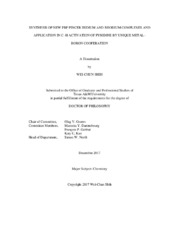| dc.description.abstract | Since first pincer ligand synthesized by Shaw, the chemistry of pincer ligands has been vastly expanded and applied in organic transformation and catalysis. Herein, we have developed new PBP-type pincer complexes that containing Lewis acidic boryl to achieve new reactivity.
In Chapter II, the facile insertion of Rh and Ir into the B–Ph bond (reversible for Rh) of PB^PhP ligand was achieved, resulting in the formation of diarylboryl PBP pincer complexes. This type of PBP has a low-lying empty orbital at boron with a high degree of Lewis acidity, allowing the central boron to interconvert between boryl, borane, and borate in the reaction with dihydrogen.
In Chapter III, a series of PBP Rh complexes with potentially bidentate oxygenous ligands have been synthesized and characterized. These complexes displayed a variety of binding modes including Z-type borane, X-type boryl, η^2-B,C binding, and bridging carboxylate.
In Chapter IV, new PBP iridium complexes that can serve as pre-catalysts for alkane transfer dehydrogenation have been reported. The turnover numbers achieved were relatively modest, but the structural and spectroscopic characterization of these PBP complexes enabled analysis of non-classical BH/Ir interactions.
In Chapter V, we have developed new PBP pincer Ir complexes that allowed pyridine to bind to the Lewis acidic boron and led to the activation of ortho C–H bond of pyridine selectively. The formation of four-membered products was achieved with several iii
pyridine derivatives. This discovery represents the first example of C–H activation directed by a Lewis acidic ligand backbone.
In Chapter VI, the synthesis of PCP/PNP-type pincer ligands and nickel complexes was achieved. By utilization of chlorophosphine as a phosphine source and magnesium or nickel powder as a reductant, this synthetic strategy permits one-pot synthesis of PCP/PNP ligands and nickel complexes from inexpensive and non-pyrophoric materials.
In Chapter VII, the synthesis of POCS bis-pincer Pd and Ni complexes has been developed. The hydroxo-bridged nickel complex demonstrated catalytic activity for nitrile hydration, but the binuclear cooperation was not verified because the monomeric complex displayed higher activity under the same condition. This result was further optimized by introducing base and up to a TON of 3050 was achieved. | en |


